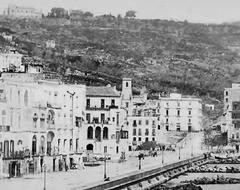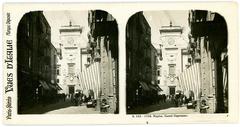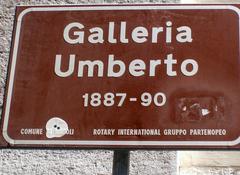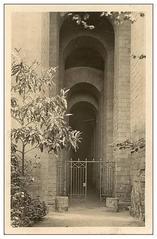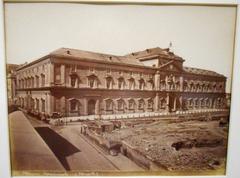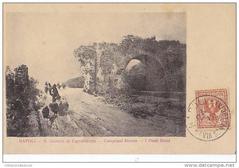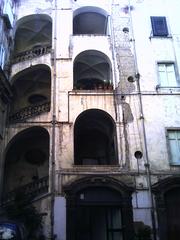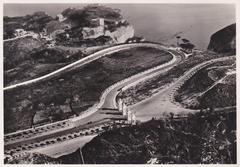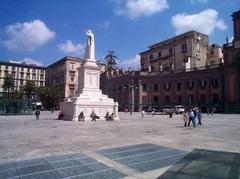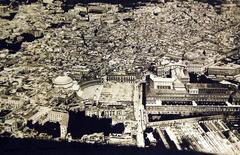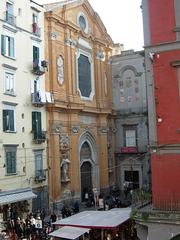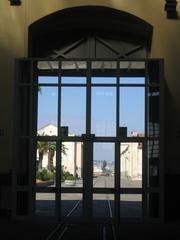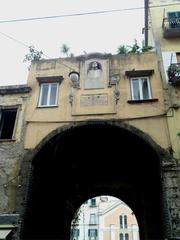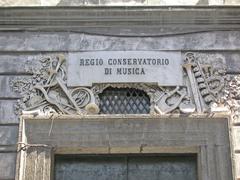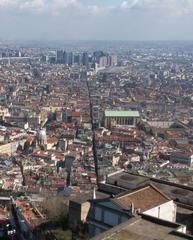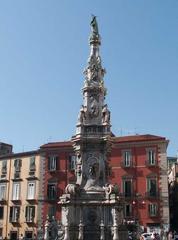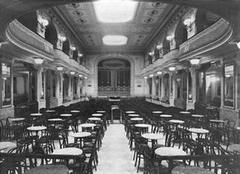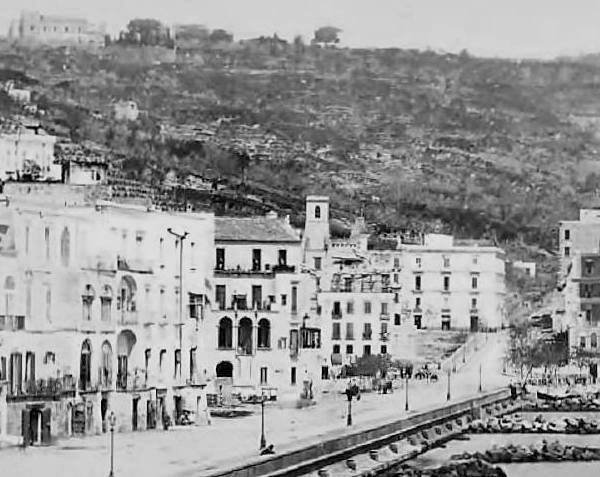
Fontana della Sirena Visiting Guide: Hours, Tickets, and Nearby Attractions in Naples
Date: 19/07/2024
Discover the history, significance, and visitor information for Fontana della Sirena in Naples.
Nestled in the heart of Naples, Italy, the Fontana della Sirena stands as a testament to the city’s rich mythological and cultural heritage. Constructed in 1869 during a transformative period of urban renewal, this iconic fountain was designed by renowned Italian sculptor Onofrio Buccino. It features the siren Parthenope, a mythical creature deeply embedded in Neapolitan lore, depicted as a beautiful mermaid. According to legend, Parthenope founded the city of Naples after washing ashore at the site where the city now stands.
This historical and artistic marvel not only serves as a symbol of Naples’ origins but also exemplifies 19th-century Neoclassical architecture with its intricate carvings and elegant lines. Visitors can enjoy the fountain’s beauty and historical significance any time of day, as it is located in the open public square of Piazza Sannazaro. This guide aims to provide a comprehensive look at the Fontana della Sirena, including its history, cultural impact, and practical information for visitors.
For more detailed insights, you can explore Naples Tourism Official Website and Italian Cultural Heritage.
Table of Contents
- Historical Background of Fontana della Sirena
- Visiting Fontana della Sirena
- Restoration and Preservation
- Cultural Impact
- Modern-Day Relevance
- FAQ
Exploring Fontana della Sirena in Naples - History, Visiting Hours, and Tickets
Historical Background of Fontana della Sirena
Origins and Construction
The Fontana della Sirena, or the Siren Fountain, is a significant historical landmark located in the bustling city of Naples, Italy. This iconic fountain was constructed in 1869, during a period of urban renewal and modernization in Naples. The fountain was designed by the renowned Italian sculptor Onofrio Buccino, who was commissioned by the city to create a public work that would both beautify the urban landscape and celebrate the city’s rich mythological heritage.
Mythological Significance
The fountain’s central figure is the siren Parthenope, a mythical creature who, according to legend, founded the city of Naples. Parthenope is depicted as a beautiful mermaid, symbolizing the city’s connection to the sea and its maritime history. The choice of Parthenope as the central figure is deeply rooted in local lore, as the siren is said to have washed ashore on the site where Naples now stands after failing to enchant Ulysses with her song. This mythological connection adds a layer of cultural and historical depth to the fountain, making it not just a piece of art but a symbol of the city’s origins and identity.
Architectural Style
The Fontana della Sirena is a fine example of 19th-century Neoclassical architecture, characterized by its elegant lines and balanced proportions. The fountain is made of white marble, which was a popular material for public monuments during this period due to its durability and aesthetic appeal. The design features a large basin with water spouts that create a cascading effect, enhancing the visual and auditory experience for visitors. The statue of Parthenope is the focal point, surrounded by intricate carvings and decorative elements that reflect the artistic trends of the time.
Historical Context
The construction of the Fontana della Sirena coincided with a period of significant political and social change in Italy. The country had recently undergone unification in 1861, and Naples, as one of the major cities, was experiencing rapid growth and modernization. Public works like the Fontana della Sirena were part of broader efforts to improve urban infrastructure and create a sense of civic pride among the residents. The fountain not only served as a source of fresh water but also as a gathering place for the community, playing a vital role in the social life of the city.
Visiting Fontana della Sirena
Visiting Hours
The Fontana della Sirena is accessible to the public 24/7, as it is located in an open public square, Piazza Sannazaro. However, the best time to visit is during daylight hours when the fountain’s artistic details are more visible and the surrounding area is bustling with activity.
Tickets and Accessibility
There is no entry fee to visit the Fontana della Sirena, making it an ideal stop for travelers on a budget. The fountain is easily accessible on foot and by public transportation. The nearby metro station, Mergellina, provides convenient access for those traveling from different parts of Naples.
Nearby Attractions
While visiting the Fontana della Sirena, you can explore other nearby attractions such as the Villa Comunale, a beautiful public park, and the historic Castel dell’Ovo, which offers stunning views of the Bay of Naples. The area around Piazza Sannazaro also features various restaurants and cafes where you can enjoy local cuisine.
Restoration and Preservation
Over the years, the Fontana della Sirena has undergone several restoration projects to preserve its structural integrity and aesthetic beauty. The most recent restoration was completed in 2019, funded by both public and private entities committed to preserving Naples’ cultural heritage. The restoration process involved cleaning the marble surfaces, repairing any structural damage, and restoring the water features to their original functionality. These efforts ensure that the fountain remains a cherished landmark for future generations to enjoy.
Cultural Impact
The Fontana della Sirena holds a special place in the hearts of Neapolitans and is a popular subject in local art and literature. It has been featured in numerous paintings, postcards, and photographs, capturing the imagination of artists and tourists alike. The fountain is also a common meeting point for locals, serving as a backdrop for social gatherings, celebrations, and public events. Its enduring presence in the city’s cultural landscape underscores its significance as more than just a historical monument but a living part of Naples’ identity.
Modern-Day Relevance
Today, the Fontana della Sirena continues to attract visitors from around the world, drawn by its historical significance and artistic beauty. It is located in the Piazza Sannazaro, a vibrant area that offers a mix of historical sites, restaurants, and shops, making it a must-visit destination for tourists exploring Naples. The fountain’s enduring appeal lies in its ability to connect the past with the present, offering a glimpse into the city’s rich history while remaining a dynamic part of its contemporary urban fabric.
FAQ
Q - What are the visiting hours for Fontana della Sirena?
A - The Fontana della Sirena is accessible 24/7, but daytime visits are recommended.
Q - Is there an entry fee to visit the Fontana della Sirena?
A - No, visiting the Fontana della Sirena is free of charge.
Q - How do I get to Fontana della Sirena?
A - The fountain is located in Piazza Sannazaro, easily accessible by foot and public transportation, including the Mergellina metro station.
Q - What are some nearby attractions?
A - Nearby attractions include Villa Comunale, Castel dell’Ovo, and various local restaurants and cafes.
Call to Action
For more detailed information on the Fontana della Sirena and its historical context, you can visit the following sources:
Discover more about Naples’ rich history and vibrant culture by exploring our other articles on Naples historical sites. Follow us on social media for the latest updates and travel tips, and don’t forget to download our mobile app Audiala for a comprehensive guide to Naples and beyond.
Summary of Key Points
The Fontana della Sirena remains an enduring symbol of Naples’ rich cultural and mythological heritage. Its historical significance, coupled with its artistic beauty, continues to captivate visitors from around the world. The fountain’s central figure, Parthenope, serves as a poignant reminder of the city’s origins and its deep connection to the sea. Accessible 24/7 and free of charge, the Fontana della Sirena offers an enriching experience for history enthusiasts, art lovers, and curious travelers alike. Its location in the vibrant Piazza Sannazaro makes it a perfect starting point for exploring other nearby attractions, such as Villa Comunale and Castel dell’Ovo. The efforts to preserve and maintain this landmark ensure that it will continue to be a cherished part of Naples’ urban fabric for generations to come. To stay updated on travel tips and cultural insights, don’t forget to download our mobile app Audiala and follow us on social media.
References
- Exploring Fontana della Sirena in Naples - History, Visiting Hours, and Tickets, 2024, Author (Naples Tourism Official Website)
- Exploring the Fontana della Sirena - Visiting Hours, Tickets, and Historical Significance in Naples, 2024, Author (Italian Cultural Heritage)
- Complete Guide to Visiting Fontana della Sirena - Tips, Attractions, and More in Naples, Italy, 2024, Author (Historical Monuments of Naples)
